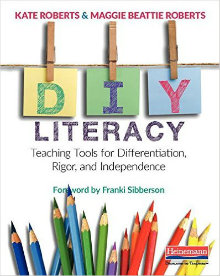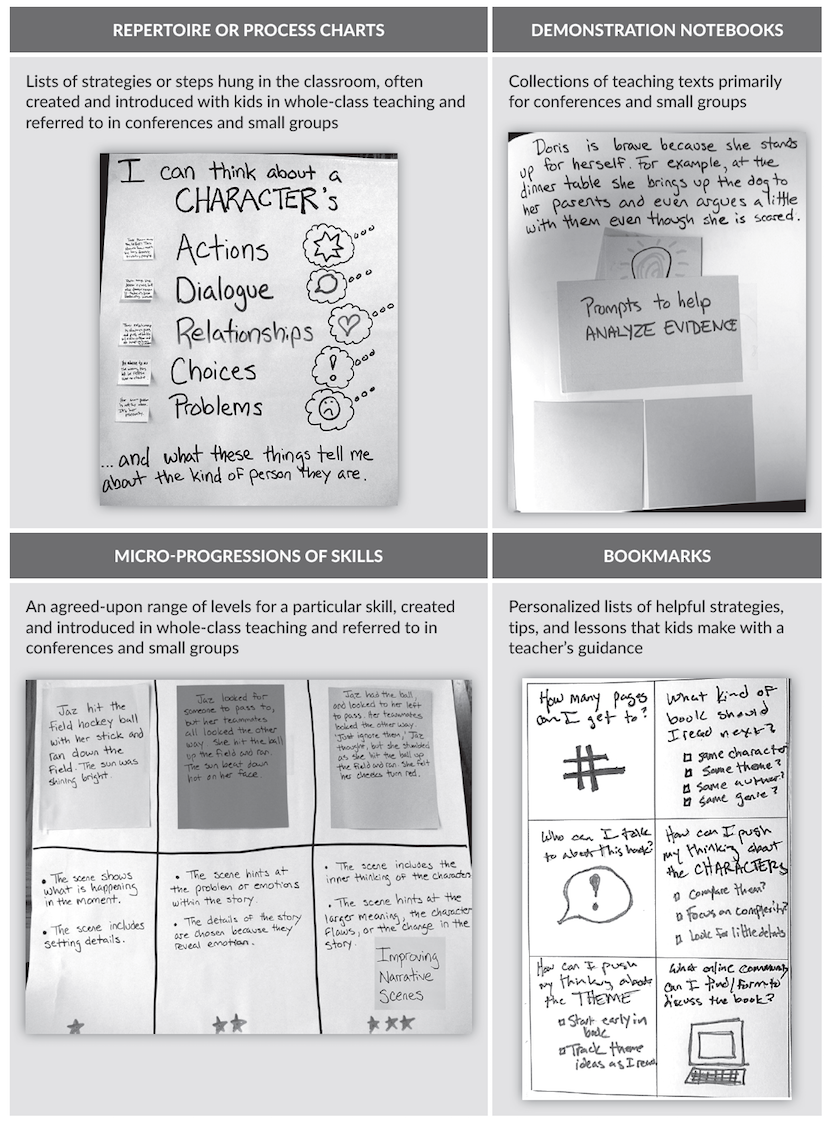Create Your Own Visual Tools for Literacy
DIY Literacy: Teaching Tools for Differentiation, Rigor, and Independence
By Kate Roberts and Maggie Beattie Roberts
(Heinemann, 2016 – Learn more)

Reviewed by Sandy Wisneski
What’s DIY Literacy? It’s making your own visual teaching tools instead of buying them. It’s using your teaching smarts to get the most from those tools. And it’s helping kids think strategically so they can be DIY learners. (Publisher’s webpage)
Anchor charts are an important part of teaching literacy along with other visual examples. I admit, creating these tools can be a struggle. There are two personal reasons:
 I often put too many ideas or strategies on one chart and it looks cluttered and ineffective.
I often put too many ideas or strategies on one chart and it looks cluttered and ineffective.- I don’t feel creative or artistic enough to make an acceptable one.
DIY Literacy: Teaching Tools for Differentiation, Rigor, and Independence breaks the process into bite-size pieces, guiding teachers through the steps of making effective visual teaching tools.
Four key teaching tools developed in the book
- Teaching Charts: Teaching into Repertoire and Process
- Demonstration Notebooks: Showing Students the How
- Micro-progression Notebook: Supporting and Clarifying Growth
- Bookmarks: Creating Personalized Action Plans
What caught my attention was the vast number of visual models throughout the book. A pleasant discovery was a bonus feature online which included companion resources for the book with links to every example printed.
Browsing all the colorful files encouraged me to get out my set of markers and draw classroom charts. The authors’ examples solved one of my problems, but what about the actual creation of visuals?
Chapter Six, “Nuts and Bolts,” offers solutions for making an engaging visual. The authors suggested several approaches:
- Use Pop Culture and Metaphors: Connecting to students’ culture pulls them into the learning process.
- Use Kid-Friendly Language: Less is more while teaching a few new things.
- Incorporate Student Voice into the Teaching Tools: When students have ownership in a visual, they are more engaged.
- Set Up Rooms to Be Teacher Tool-Friendly: This may seem like common sense but is something to consider.
Specific components to counter any lack of artistic ability
The authors break down design elements into what matters most for an effective visual. Suggestions are specific and clearly modeled.
- Be sure to make use of white space and leave wide margins.
- Write big and separate sections to draw attention to chunks of text.
- Color makes teaching tools attractive.
- “Brand” certain types of teaching with specific colors.
The chapter ends with a reminder to teachers: “But in the end, it is far, far more important that teaching tools be helpful to kids, not attractive.”
A well-rounded book
DIY Literacy is not only a “how-to” book on designing visual tools but a source of advice on implementation in the classroom. Students’ learning is changed by concrete ideas that push them forward into independent problem solving. A quote from the authors’ blog, Indent, explains: “It’s about the personalized touch; it’s about being playful in our teaching while reaching toward academic excellence; it’s about being imperfect in the most perfect ways.”
Sandy Wisneski is a lead teacher at Catalyst Charter Middle School, which opened in the fall of 2013. She is the district Webmaster, tech mentor, yearbook advisor, and Common Sense Media Educator, as well as IE mentor. Over the past 40 years she obtained her masters in reading and became certified as a Flat Classroom Teacher, a Graphite Certified Teacher, and a BrainPOP Certified Educator. The summer of 2014 she attended Honeywell Educators @ Space Academy. She enjoys challenging students to “take ownership” for their learning and to be effective digital citizens in the world.

































